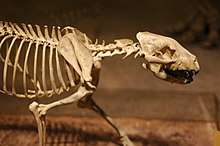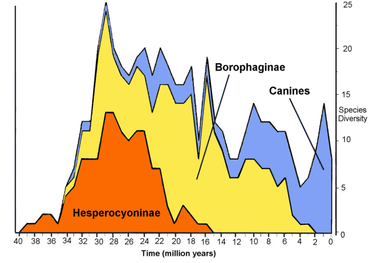Borophaginae
The extinct Borophaginae form one of three subfamilies found within the canid family. The other two canid subfamilies are the extinct Hesperocyoninae and extant Caninae.[2] Borophaginae, called "bone-crushing dogs",[3][4] were endemic to North America during the Oligocene to Pliocene and lived roughly 36—2.5 million years ago, existing for about 33.5 million years.
| Borophaginae | |
|---|---|
 | |
| Aelurodon stirtoni | |
| Scientific classification | |
| Kingdom: | Animalia |
| Phylum: | Chordata |
| Class: | Mammalia |
| Order: | Carnivora |
| Family: | Canidae |
| Subfamily: | †Borophaginae Simpson (1945)[1] |
| Genera | |
|
See text | |
Origin
| Canid subfamilies | |||||||||||||||
|
The Borophaginae descended from the subfamily Hesperocyoninae. The earliest and most primitive borophagine is the genus Archaeocyon, which is a small fox-sized animal mostly found in the fossil beds in western North America. The borophagines soon diversified into several major groups. They evolved to become considerably larger than their predecessors, and filled a wide range of niches in late Cenozoic North America, from small omnivores to powerful, bear-sized carnivores, such as Epicyon.[5]
Species
There are 66 identified borophagine species, including 18 new ones that range from the Orellan to Blancan ages. A phylogenetic analysis of the species was conducted using cladistic methods, with Hesperocyoninae as an archaic group of canids, as the outgroup. Aside from some transitional forms, Borophaginae can be organized into four major clades: Phlaocyonini, Cynarctina, Aelurodontina, and Borophagina (all erected as new tribes or subtribes). The Borophaginae begins with a group of small fox-sized genera, such as Archaeocyon, Oxetocyon, Otarocyon, and Rhizocyon, in the Orellan through early Arikareean stages.[5] These canids reached their maximum diversity of species around 28 million years ago.
Often generically referred to as "bone-crushing dogs" for their powerful teeth and jaws, and hyena-like features (although their dentition was more primitive than that of hyenas), their fossils are abundant and widespread; in all likelihood, they were probably one of the top predators of their ecosystems.[5][6] Their good fossil record has also allowed a detailed reconstruction of their phylogeny, showing that the group was highly diverse in its heyday.[5] All Borophaginae had a small fifth toe on their rear feet (similar to the toes that bear dew claws on the front feet), where as all modern Caninae have only four toes normally.[7]
Noteworthy genera in this group are Aelurodon, Epicyon, and Borophagus (=Osteoborus). According to Xiaoming Wang, the Borophaginae played broad ecological roles that are performed by at least three living carnivoran families, Canidae (which they were a part of), Hyaenidae, and Procyonidae.


Classification
Borophagine taxonomy, following Wang et al.[5] (million years=in existence)
- Family Canidae
- Subfamily †Borophaginae
- †Archaeocyon 33—26 Ma, existing 7 million years
- †Oxetocyon 33—28 Ma, existing 4 million years
- †Otarocyon 34—30 Ma, existing 4 million years
- †Rhizocyon 33—26 Ma, existing 4 million years
- Tribe †Phlaocyonini 33—13 Ma, existing 20 million years
- †Cynarctoides 30—18 Ma, existing 12 million years
- †Phlaocyon 30—19 Ma,11 million years
- Tribe †Borophagini 30—3 Ma, existing 27 million years
- †Cormocyon 30—20 Ma, existing 10 million years
- †Desmocyon 25—16 Ma, existing 9 million years
- †Metatomarctus 19—16 Ma, existing 3 million years
- †Euoplocyon 18—16 Ma, existing 2 million years
- †Psalidocyon 16—13 Ma, existing 7 million years
- †Microtomarctus 21—13 Ma, existing 7 million years
- †Protomarctus 20—16 Ma, existing 4 million years
- †Tephrocyon 16—14 Ma, existing 2.7 million years
- Subtribe †Cynarctina 20—10 Ma, existing 10 million years
- †Paracynarctus 19—16 Ma, existing 3 million years
- †Cynarctus 16—12 Ma, existing 4 million years
- Subtribe †Aelurodontina 20—5 Ma, existing 15 million years
- Subtribe †Borophagina
- †Paratomarctus 16—5 Ma, existing 11 million years
- †Carpocyon 16—5 Ma, existing 11 million years
- †Protepicyon 16—12 Ma, existing 2.7 million years
- †Epicyon 12—10 Ma, existing 2 million years
- †Borophagus (=Osteoborus) 12—5 Ma, existing 7 million years
- Subfamily †Borophaginae
Cladogram showing borophagine interrelationships, following Wang et al., figure 141:[5]
| Canidae |
| |||||||||||||||||||||||||||||||||||||||||||||||||||||||||||||||||||||||||||||||||||||||||||||||||||||||||||||||||||||||||||||||||||||||
Extinction
According to an analysis of the fossil record of North American fossil carnivorans, the decline of borophagines from a diversity of about 30 species 15 million years ago to extinction was largely driven by competition with felids and canines.[8] Felids invaded the continent from Eurasia about 20 million years ago and were better ambush predators, in part due to their retractable claws.[9] Climate change, which led to the replacement of North American forests with grasslands, may also have been a factor;[10] borophagines were less suited to running down prey than canines.[8]
References
- Simpson, G.G. (1945). "The principles of classification and a classification of mammals". Bulletin of the American Museum of Natural History. 85: i–xvi, 1–350. hdl:2246/1104.
- Miklosi, Adam (2015). Dog Behaviour, Evolution, and Cognition. Oxford Biology (2 ed.). Oxford University Press. pp. 103–107. ISBN 978-0199545667.
- Borophaginae in the Paleobiology Database
- Borophaginae at fossilworks.org (retrieved 29 August 2018)
- Wang, Xiaoming; Tedford, Richard; Taylor, Beryl (1999-11-17). "Phylogenetic systematics of the Borophaginae (Carnivora, Canidae)". Bulletin of the American Museum of Natural History. 243. hdl:2246/1588.
- Turner, Alan (2004). Prehistoric Mammals. Washington, D.C.: National Geographic. pp. 112–114. ISBN 0792271343. OCLC 54079923.
- Wang, Xiaoming; Tedford, Richard H. (2008). Dogs : their fossil relatives and evolutionary history. New York: Columbia University Press. ISBN 9780231135283. OCLC 185095648.
- Silvestro, D.; Antonelli, A.; Salamin, N.; Quental, T. B. (2015). "The role of clade competition in the diversification of North American canids". Proceedings of the National Academy of Sciences. 112 (28): 8684–8689. doi:10.1073/pnas.1502803112. PMC 4507235. PMID 26124128.
- Perry, D. (2015-08-14). "Smarts, stealth and retractable claws: Science confirms cats are better than dogs". OregonLive.com. The Oregonian. Archived from the original on 2015-08-18. Retrieved 2016-09-03.
- Figueirido, B.; Martín-Serra, A.; Tseng, Z. J.; Janis, C. M. (2015-08-18). "Habitat changes and changing predatory habits in North American fossil canids". Nature Communications. 6: 7976. doi:10.1038/ncomms8976. PMID 26285033.
Further reading
- Wang, X.; Tedford, R. H.; Antón, M. (2010). Dogs: Their Fossil Relatives and Evolutionary History. New York: Columbia University Press. ISBN 978-0-231-13529-0.
- Kathleen Munthe (1989). The Skeleton of the Borophaginae (Carnivora, Canidae): Morphology and Function. University of California Press. ISBN 978-0-520-09724-7.